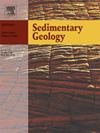主成分分析揭示了碳酸盐岩相、地球化学性质与成岩叠印之间的关系
IF 2.9
2区 地球科学
Q1 GEOLOGY
引用次数: 0
摘要
在过渡海岸-盆地环境下的海相碳酸盐档案容易受到同沉积蚀变和沉积后蚀变的影响,这一特征使沉积档案中编码的原始环境信号的解释变得复杂。本研究利用主成分分析(PCA)来阐明Kazhdumi陆架盆地(Zagros盆地)下Aptian碳酸盐岩中相类型、环境控制和沉积物各自对地球化学重置的成岩敏感性之间的复杂关系。重点是近中斜坡到陆架内盆地的碳酸盐岩。综合相分析、岩石学、地球化学和主成分分析,得出以下结果:(i)近端相表现出较高的Mn/Ca和较低的Sr/Ca比率,这与增强的流体-岩石相互作用和陆源输入有关。海相δ13C值和Sr/Ca比值的升高在远端相中更为明显。(ii)远端碳酸盐岩体同位素值以δ13C富集和δ18O亏缺为特征。这表明,在较冷的水域和间歇性缺氧-缺氧条件下,海洋生产力会增加。(iii)在较浅、较暖、氧合良好的中斜坡近端水体中,有机碳埋藏减少、陆源轻碳同位素化和有机质氧化导致δ13C值降低,δ18O值升高。研究表明,尽管存在复杂的成岩叠印,但海洋代理信号仍然可识别。在微相数据的支持下,PCA揭示了一个多方面的系统,该系统在相/水深背景下驱动地球化学变化。这一结果强调了详细的相分析和地球化学剖面在重建古环境条件中的重要性。本文章由计算机程序翻译,如有差异,请以英文原文为准。
Principal component analysis reveals the relationship between carbonate facies, geochemical properties, and diagenetic overprint
Marine carbonate archives in transitional coastal-to-basin settings are susceptible to syn- and post-depositional alteration, a feature that complicates the interpretation of primary environmental signals encoded in the sedimentary archive at the time of deposition. This study utilises Principal Component Analysis (PCA) to elucidate the intricate relationships between facies types, environmental controls, and the sediments' respective diagenetic susceptibilities to geochemical resetting within lower Aptian carbonates of the Kazhdumi Intrashelf Basin (Zagros Basin, Iran). The focus is on proximal mid-ramp to intrashelf-basin carbonates. Integrating facies analysis, petrography, geochemistry, and PCA, the following outcomes result: (i) Proximal facies exhibit higher Mn/Ca and lower Sr/Ca ratios linked to enhanced fluid-rock interactions and terrigenous input. Marine δ13C values and elevated Sr/Ca ratios are more pronounced in distal facies. (ii) Bulk isotope values from distal carbonates are characterised by enriched δ13C and depleted δ18O values. This suggests increased marine productivity in cooler waters and intermittently anoxic-suboxic conditions. (iii) In shallower, warmer, and well‑oxygenated proximal mid-ramp waters, reduced organic carbon burial, isotopically light carbon from terrestrial sources and the oxidation of organic matter result in lowered δ13C and higher δ18O values. The study demonstrates that despite complex diagenetic overprint, marine proxy signals remain discernible. Supported by microfacies data, PCA reveals a multi-faceted system that drives geochemical variability within a facies/bathymetric context. This outcome emphasises the critical importance of detailed facies analysis and geochemical profiling in reconstructing palaeoenvironmental conditions.
求助全文
通过发布文献求助,成功后即可免费获取论文全文。
去求助
来源期刊

Sedimentary Geology
地学-地质学
CiteScore
5.10
自引率
7.10%
发文量
133
审稿时长
32 days
期刊介绍:
Sedimentary Geology is a journal that rapidly publishes high quality, original research and review papers that cover all aspects of sediments and sedimentary rocks at all spatial and temporal scales. Submitted papers must make a significant contribution to the field of study and must place the research in a broad context, so that it is of interest to the diverse, international readership of the journal. Papers that are largely descriptive in nature, of limited scope or local geographical significance, or based on limited data will not be considered for publication.
 求助内容:
求助内容: 应助结果提醒方式:
应助结果提醒方式:


